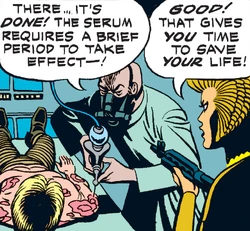Bledsoe's disease was a virus transmitted by air and physical contact.[3] It was named after Doctor Bledsoe.[source?] Squills were known to be carriers of the disease.[1]
Different strains of the disease existed, each causing unique reactions. Commonly, Bledsoe's caused the skin to burn, followed gradually by discoloration of the eyes. The discoloration resolved itself into a starfield pattern, which, despite appearances, had absolutely no impact on the eyesight of the afflicted. Late stages of the disease also include a sense of dizziness.[1]
Kaaldar's secret strain and the Imperial plot[]

Kaaldar injecting Luke Skywalker with the serum for his strain of Bledsoe's as Anduvil looks on
Around 0 ABY, a strain of the virus was created by Dr Kaaldar, an elite Imperial scientist, and an outbreak was orchestrated. The purpose was twofold: to undermine the social order of dissatisfied worlds, and to locate secret bases of the Rebel Alliance. Genetic manipulation of the virus could encode information that would affect the symptoms; one symptom of the disease, referred to as the "window effect," was thus engineered as a secret courier of star charts. Through the eyes of afflicted individuals, Imperial scientists could locate a star map via an ocular printer which revealed the location of Rebel bases for targeting by the Imperial Fleet.[1][3]
Imperial forces watched for outbreaks of Bledsoe's and used the discoloration as a silent means of communication and strategics. However, the effect did not last long after death, as evidenced by various stormtroopers being unable to find anything in the eyes of Jawas that were long deceased upon finding their sandcrawler.
As a means of ensuring this, the Imperials injected several squills with the Bledsoe's disease. Squills were naturally resistant to the disease, thus making them excellent carriers. The squills were then placed into transport containers and launched towards unsuspecting planets suspected of harboring Rebel sympathizers, including Tay'ah'loo, Ogem, and Tatooine. Although the infection of the former two planets went as planned, with the Rebel Outpost on Kholes being located and wiped out by the Empire shortly thereafter, the latter planet backfired after a troupe of Jawas unwittingly intercepted the transport capsule. In addition, it was frequent enough that the Rebel Alliance eventually ordered Luke Skywalker to carry out a mission to Tatooine to investigate, to the latter's reluctance.
Behind the scenes[]

Star in the eyes, as it appeared in the 1979 original version of the strip (note the ringed planetary object at the bottom right portion of the eye).
There was a slight change to the "stars in the eyes" effect between Tatooine Sojourn's initial release in 1979 and the republished color version. In the original release, after Luke Skywalker was infected with Bledsoe's, a ringed planetary body was in the bottom right portion of his "star eye." This planetary body was removed in the rereleased colored versions.
Appearances[]
- "Tatooine Sojourn" (First appearance)
Sources[]
 "ComicScan: Coming Full Circle" — Star Wars Galaxy Collector 3 (Indirect mention only)
"ComicScan: Coming Full Circle" — Star Wars Galaxy Collector 3 (Indirect mention only)- Star Wars: The Comics Companion
- The Complete Star Wars Encyclopedia
 Anduvil of Ogem in the Databank (content now obsolete; backup link)
Anduvil of Ogem in the Databank (content now obsolete; backup link)
Notes and references[]
- ↑ 1.00 1.01 1.02 1.03 1.04 1.05 1.06 1.07 1.08 1.09 1.10 "Tatooine Sojourn"
- ↑ The events of Tatooine Sojourn implied that it took place after the Rebel Alliance's destruction of the Death Star at Yavin, which takes place in 0 ABY, according to The New Essential Chronology.
- ↑ 3.0 3.1 The Complete Star Wars Encyclopedia

